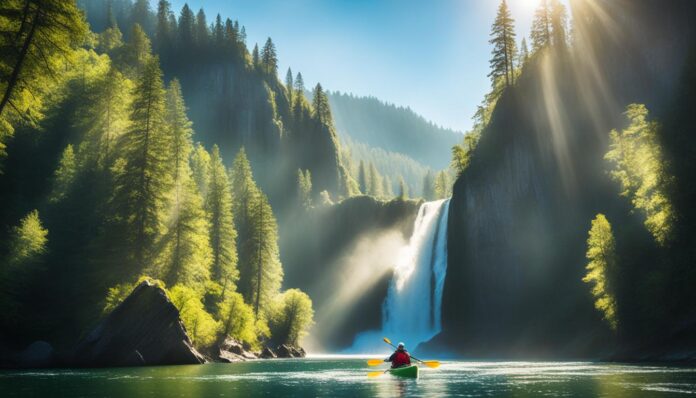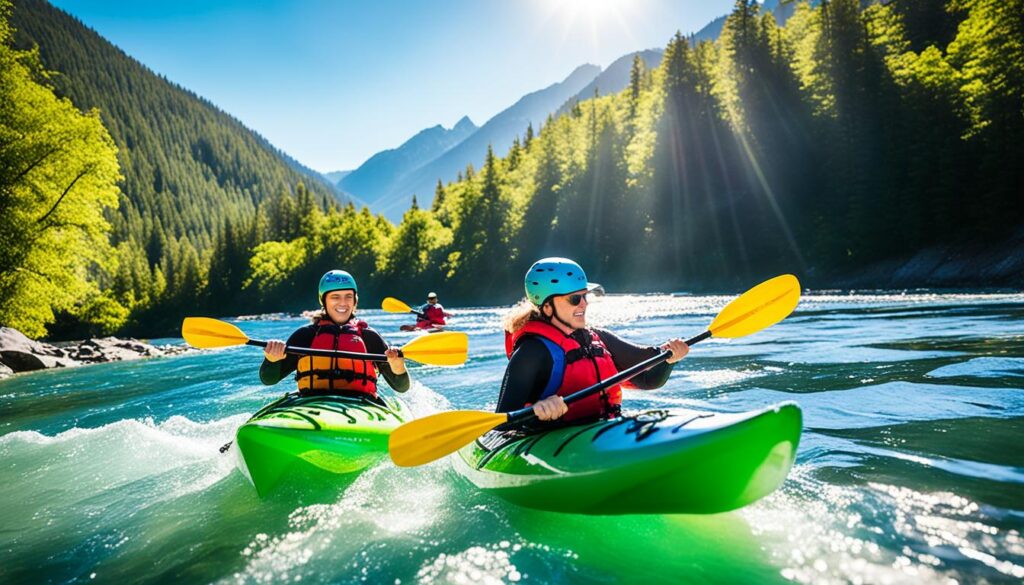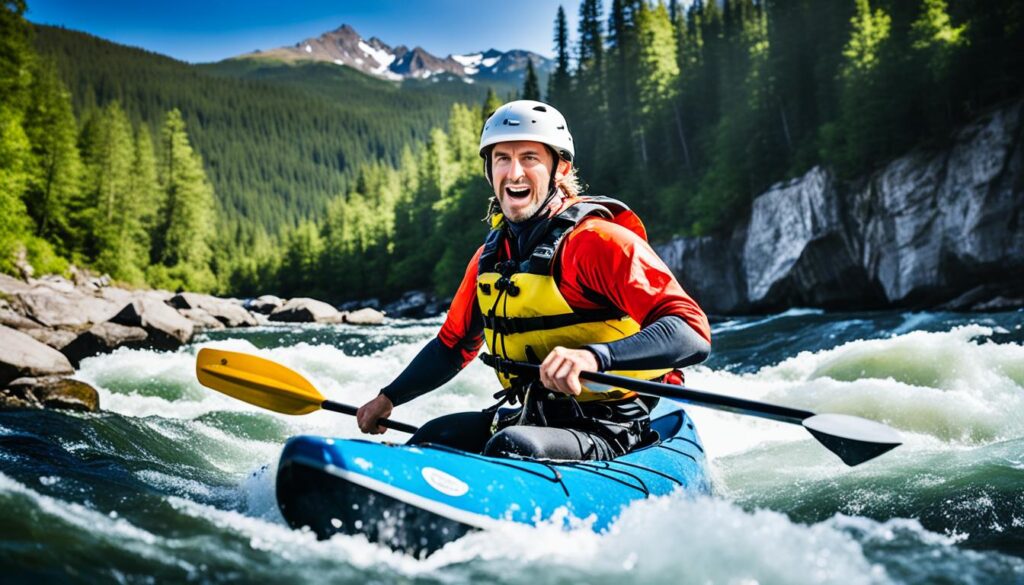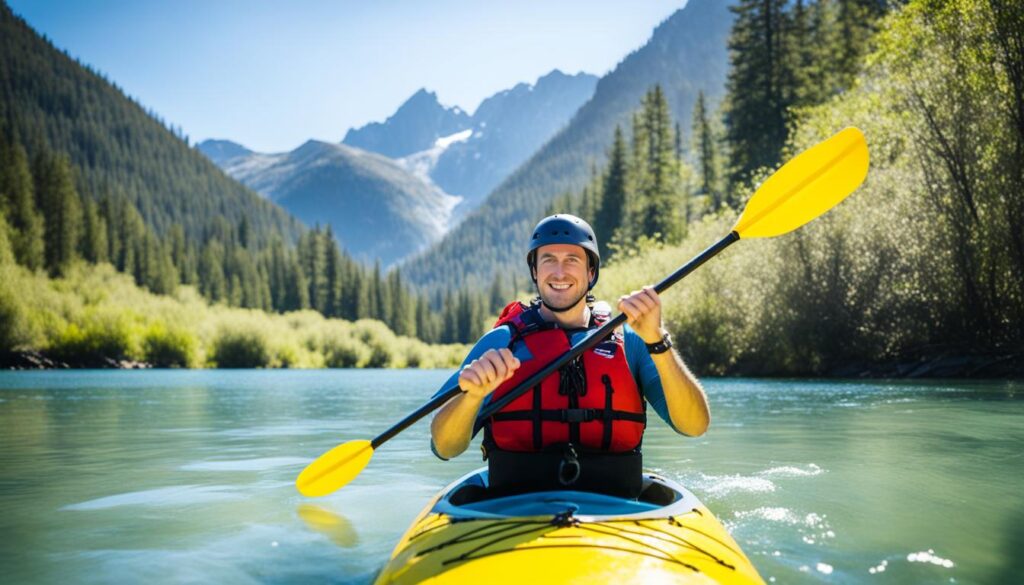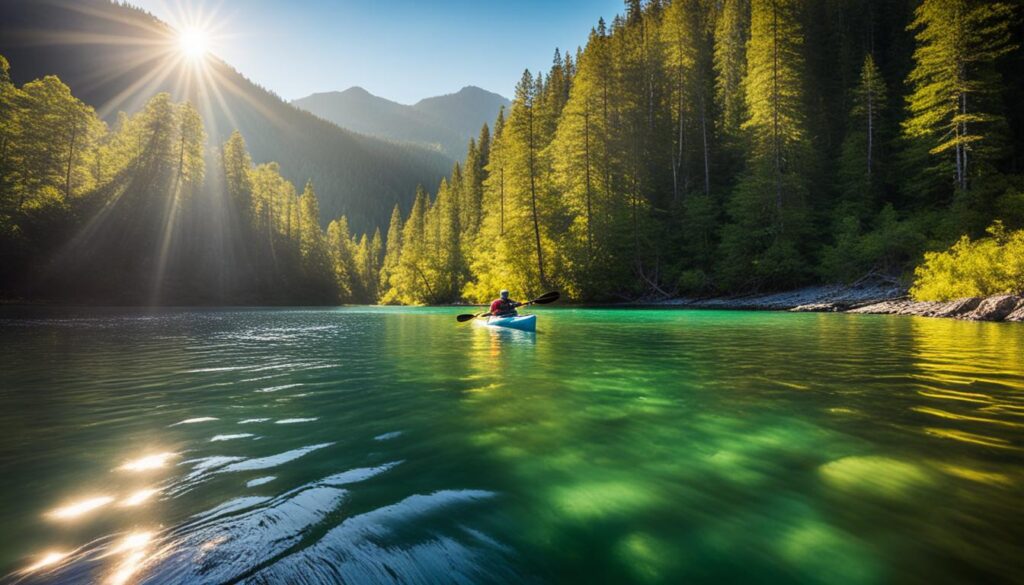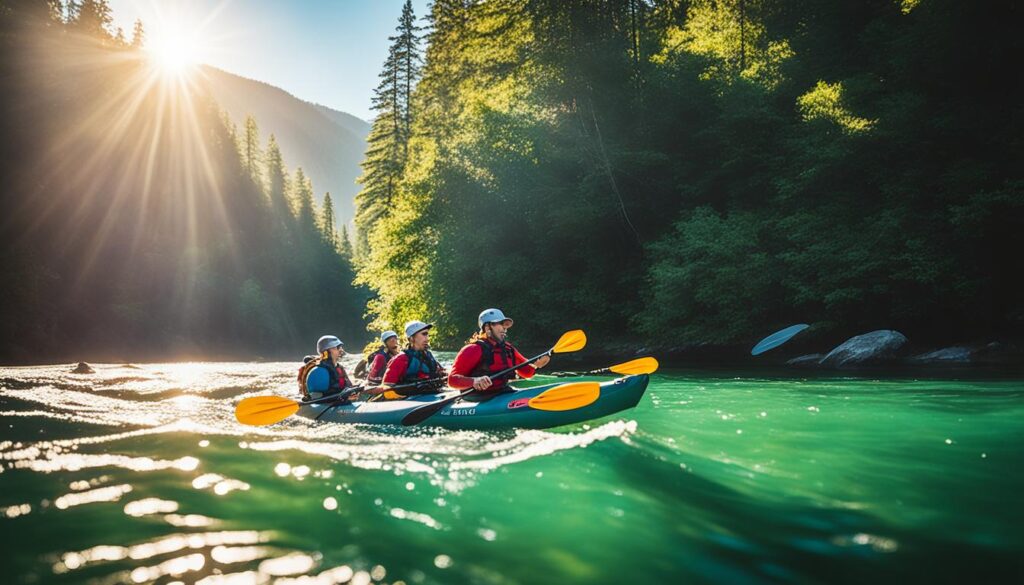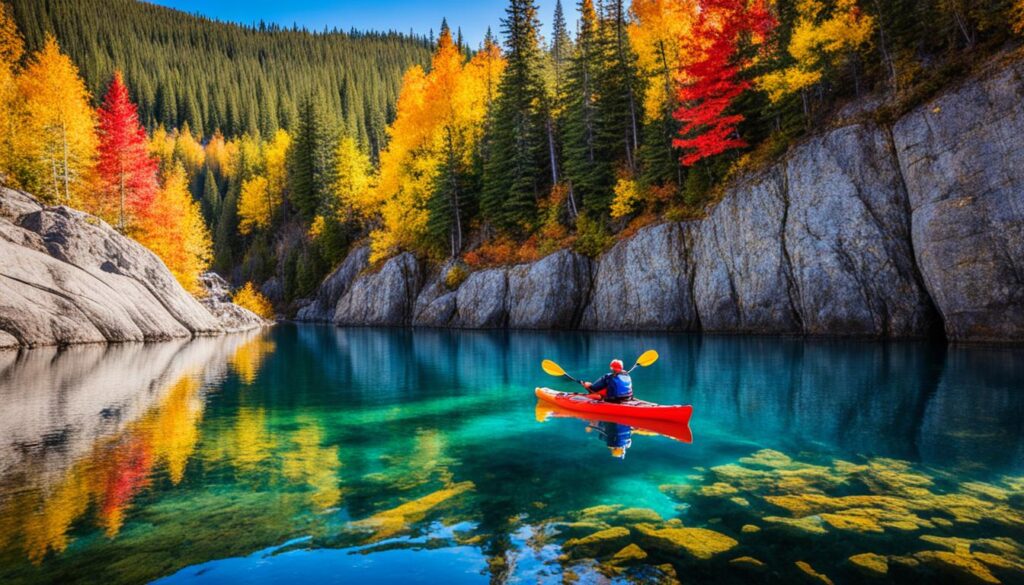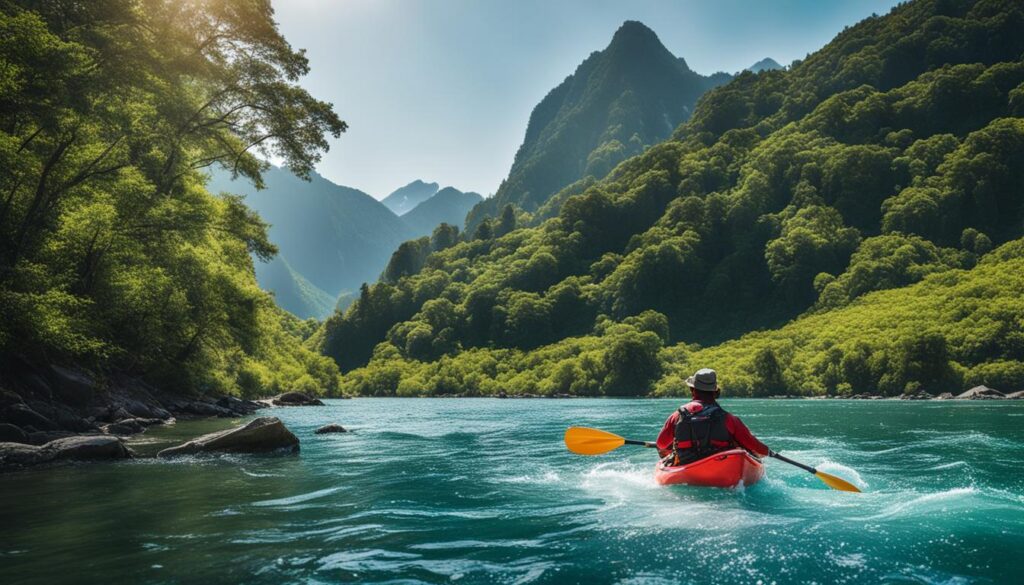Have you ever dreamed of gliding through crystal-clear waters, surrounded by breathtaking scenery? Imagine the serenity of paddling along tranquil lakes and vibrant rivers, immersing yourself in the beauty of nature. Now, what if we told you that you can learn to kayak in Canada’s stunning waterways, creating unforgettable memories along the way?
Learning to kayak opens up a world of adventure and allows you to connect with nature in a unique way. Whether you’re a complete beginner or have some experience, kayaking in Canada offers incredible opportunities to explore its vast and diverse waterways.
In this article, we will guide you through the process of learning to kayak in Canada, providing valuable information on kayak lessons, beginner tips, choosing the right equipment, safety guidelines, and much more. Get ready to embark on an exhilarating journey and discover the wonders of kayaking in Canada!
Choosing the Right Equipment
Before embarking on your kayaking adventure, it’s important to start with the right equipment. Whether you’re a beginner taking kayak lessons or an experienced paddler, having the proper gear ensures a safe and enjoyable experience on the water.
Kayaks for Beginners
When it comes to choosing a kayak, there are several factors to consider. Beginners should opt for stable and easy-to-maneuver kayaks. Sit-on-top kayaks are a popular choice for beginners as they offer stability and are easy to get in and out of. Additionally, recreational kayaks with wider hulls provide extra stability, making them ideal for beginners.
Paddles for Beginners
Equally important is selecting the right paddle. The size of the paddle depends on your height and the width of the kayak. A paddle that’s too long or too short can cause discomfort and make paddling more challenging. Choose a paddle with adjustable length for versatility and comfort.
Essential Gear
Aside from kayaks and paddles, there are essential gear items that should never be overlooked:
- Life Jacket: A properly fitting life jacket, also known as a personal flotation device (PFD), is a must for every kayaker. Ensure it is U.S. Coast Guard-approved and fits snugly.
- Safety Equipment: Carry a whistle or a signaling device to attract attention in case of an emergency on the water.
- Dry Bag: Keep your personal belongings protected from water by using a dry bag.
- Sun Protection: Don’t forget to wear sunscreen, a hat, and sunglasses to protect yourself from the sun’s harmful rays.
- Waterproof Phone Case: Invest in a waterproof phone case to keep your phone safe and accessible for emergencies or capturing memorable moments.
Remember, safety should always be your top priority when kayaking, so make sure to equip yourself with the necessary gear.
“Choosing the right equipment is crucial for a successful and enjoyable kayaking experience. Investing in quality gear ensures your safety and comfort on the water.” – Sarah Thompson, Experienced Kayaker
| Type of Kayak | Suitable For |
|---|---|
| Sit-on-top Kayak | Beginners, easy entry and exit, stability |
| Recreational Kayak | Beginners, wider hull for stability |
| Touring Kayak | Intermediate to advanced paddlers, longer trips, speed and maneuverability |
| Inflatable Kayak | Beginners and experienced paddlers, easy storage and transportation |
Essential Safety Tips for Beginner Kayakers
Safety should always be a top priority when embarking on a kayaking adventure. Whether you’re exploring tranquil lakes or thrilling rivers, it’s important to stay prepared and aware of potential risks. In this section, we will provide you with essential safety tips that every beginner kayaker should keep in mind.
1. Properly Wear a Life Jacket
Key tip: Never underestimate the importance of wearing a properly fitting life jacket when kayaking. It can save your life in an emergency.
A life jacket is not just a piece of gear—it’s your lifeline on the water. Make sure to wear a Coast Guard-approved life jacket that fits snugly and is suitable for kayaking. Ensure all straps are properly fastened, and the jacket does not restrict your ability to paddle.
Remember, accidents can happen unexpectedly, and it’s better to be safe than sorry. Always wear your life jacket, no matter how experienced a kayaker you may become.
2. Understand Weather Conditions
Key tip: Check weather forecasts and be aware of changing conditions before heading out on the water.
Weather conditions can greatly impact your kayaking experience. Before you set off, check local weather forecasts and pay attention to any advisories or warnings. Observe the wind speed, tide, and current conditions, as they can impact your ability to paddle and maintain control of your kayak.
If you notice deteriorating weather conditions while kayaking, it’s essential to prioritize your safety. Seek shelter, return to shore, or find a safe location until conditions improve.
3. Learn Basic Rescue Techniques
Key tip: Familiarize yourself with basic rescue techniques to handle unexpected situations on the water.
Even with proper precautions, accidents can still occur. That’s why it’s crucial to learn basic rescue techniques to handle common emergencies while kayaking. These techniques include:
- Towing: Knowing how to tow another kayaker in distress or be towed by a nearby vessel.
- Eskimo Roll: Mastering the skill of righting your kayak after a capsize by rolling upright.
- Self-Rescue: Understanding how to safely exit and reenter your kayak in open water.
By learning and practicing these techniques, you’ll be better equipped to handle unexpected situations and ensure your own safety, as well as the safety of others.
Note: Take a moment to appreciate the breathtaking beauty and serene environment that kayaking offers. However, always stay cautious and follow safety guidelines to fully enjoy your kayaking experience.
Basic Kayaking Techniques for Beginners
Mastering basic kayaking techniques is crucial for a smooth and enjoyable experience on the water. Whether you’re new to kayaking or looking to improve your skills, understanding the correct paddling techniques, steering and maneuvering your kayak, and essential strokes for different situations is essential. So, let’s dive into some beginner kayaking tips that will help you navigate the water with confidence.
Paddling Techniques
Proper paddling techniques are fundamental to kayaking. Here are some key points to keep in mind:
- Hold the paddle with both hands, keeping your arms slightly bent and your hands shoulder-width apart.
- Engage your core muscles and rotate your torso as you paddle to generate power.
- Submerge the entire blade in the water during each stroke and pull it backward, starting from the foot of the kayak towards your hips.
- Maintain a steady rhythm and avoid splashing to maximize efficiency.
Steering and Maneuvering
Being able to steer and maneuver your kayak effectively is essential for navigation and avoiding obstacles. Follow these tips:
- To turn left, paddle on the right side of the kayak. To turn right, paddle on the left side.
- Use short, quick strokes to make tight turns and longer, sweeping strokes for wider turns.
- Lean your body slightly in the direction you want to turn to enhance stability and control.
Remember, practice makes perfect when it comes to mastering these techniques. Spend time on calm waters to refine your skills before taking on more challenging conditions.
“Mastering basic kayaking techniques is the foundation for an enjoyable and safe experience on the water.” – John Johnson, experienced kayaker
Now that you have a better understanding of the basic kayaking techniques, it’s time to hit the water and put your skills to the test. Remember to always prioritize safety, wear proper gear, and be aware of your surroundings. With practice and perseverance, you’ll soon become a confident kayaker, ready to explore new horizons.
Exploring Canada’s Best Kayaking Spots
When it comes to kayaking, Canada is a paradise of mesmerizing waterways waiting to be explored. From tranquil lakes to powerful rivers, this vast country offers a multitude of kayaking spots that showcase its breathtaking natural beauty and provide unforgettable adventures. Whether you’re a beginner or an experienced paddler, these top kayaking destinations in Canada are sure to captivate your senses.
Lake Louise
Cascading glaciers and crystal-clear turquoise waters make Lake Louise in Banff National Park a picturesque location for kayaking. Dip your paddle into the serene lake and take in the panoramic views of snow-capped mountains as you glide across the tranquil waters. Keep an eye out for the diverse wildlife that call this area home, including majestic elk and elusive beavers.
Nahanni River
The Nahanni River in Nahanni National Park Reserve offers a thrilling kayaking experience for adventurous souls. As you navigate through the canyons and cascading waterfalls of this UNESCO World Heritage site, you’ll be surrounded by towering cliffs and lush boreal forests. Get ready for an adrenaline rush and immerse yourself in the raw beauty of the Nahanni River.
Johnston Strait
Johnston Strait, located off the northeast coast of Vancouver Island, is renowned for its vibrant marine life and stunning coastal landscapes. Paddle alongside orcas, humpback whales, seals, and sea lions as they navigate the nutrient-rich waters. The calm, protected waters of Johnston Strait make it an ideal destination for both beginner and experienced kayakers.
| Destination | Key Highlights |
|---|---|
| Lake Louise | Spectacular views, glacier-fed turquoise waters, and diverse wildlife. |
| Nahanni River | Thrilling rapids, breathtaking canyons, and lush boreal forests. |
| Johnston Strait | Close encounters with orcas, humpback whales, and diverse marine life. |
No matter where you choose to kayak in Canada, be sure to respect the natural environment, follow local regulations, and practice responsible kayaking. Remember to pack essential safety gear, dress appropriately for the weather, and always let someone know about your intended route. Now, it’s time to grab your paddle and embark on an unforgettable journey through Canada’s best kayaking spots.
Planning a Guided Kayak Tour
If you prefer a guided experience, joining a guided kayak tour in Canada is an excellent choice. These tours are led by experienced instructors who will ensure your safety and provide valuable insights into exploring Canadian rivers by kayak. Let’s explore the benefits of guided tours, how to choose the right one for your skill level, and what you can expect during the excursion.
Benefits of Guided Kayak Tours
1. Expert Guidance: With a guided kayak tour, you’ll have the opportunity to learn from experienced instructors who can provide valuable guidance on proper paddling techniques, safety procedures, and navigating through challenging waters.
2. Access to Hidden Gems: The guides on these tours have in-depth knowledge of the best kayaking routes, taking you to stunning locations and hidden gems that you might not discover on your own.
3. Safety and Support: Guided tours prioritize safety, ensuring that you have the necessary equipment, knowledge, and support throughout the excursion. Instructors are trained to handle emergencies and can provide assistance if needed.
Choosing the Right Guided Kayak Tour
When selecting a guided kayak tour, consider the following factors:
- Experience Level: Look for tours that cater to your skill level, whether you’re a beginner or an experienced kayaker. Some tours are designed specifically for beginners, while others offer more challenging routes for advanced paddlers.
- Group Size: Consider the size of the tour group. Smaller groups often provide a more personalized experience, allowing for better interaction with the instructor and a closer-knit kayaking community.
- Destination: Research the destinations offered by different tours and choose one that aligns with your preferences. Whether you’re interested in serene lakes, picturesque rivers, or coastal adventures, there’s a guided tour to suit your taste.
- Duration: Check the duration of the tour and ensure it fits your schedule. Some tours may last just a few hours, while others offer multi-day adventures, allowing for a more immersive kayaking experience.
What to Expect on a Guided Kayak Tour
During a guided kayak tour, you can expect:
- Pre-trip briefing and safety instructions
- Guided paddling sessions with instructors
- Opportunities for wildlife spotting and nature exploration
- Rest breaks at scenic spots
- Insights into the local flora, fauna, and history of the area
- Support and assistance from instructors throughout the tour
Embark on a guided kayak tour and experience the joy of exploring Canadian rivers in the company of knowledgeable guides and fellow kayakers.
| Guided Kayak Tour Company | Location | Tour Duration |
|---|---|---|
| Wilderness Adventures | British Columbia | 3 days |
| Great Lakes Kayak Expeditions | Ontario | 1 day |
| Coastal Explorations | New Brunswick | 5 days |
Wildlife Encounters While Kayaking
One of the many remarkable experiences while exploring Canadian rivers by kayak is the chance to encounter a diverse range of fascinating wildlife. Paddling through the stunning waterways of Canada offers a unique opportunity to observe these magnificent creatures up-close in their natural habitats.
As you navigate the tranquil lakes and rivers, keep your eyes open for a variety of wildlife species that call these waterways home. From majestic bald eagles soaring above to graceful moose drinking from the water’s edge, there is an abundance of animals to discover. Keep in mind that wildlife encounters can be unpredictable, so it’s essential to approach them with caution and respect.
Here are some of the incredible animals you may encounter while kayaking in Canada:
“The greatness of a nation can be judged by the way its animals are treated.” – Mahatma Gandhi
Bald Eagles
Bald eagles are a common sight along Canadian waterways. With their striking white heads and impressive wingspan, these raptors are a symbol of freedom and strength. Keep an eye out for their aerial displays as they soar through the sky, searching for fish in the rivers below.
Moose
The elusive moose, the largest member of the deer family, often frequents the shores and marshy areas of Canadian lakes and rivers. Spotting a moose gracefully wading through the water or munching on vegetation is an awe-inspiring sight.
Beavers
The iconic symbol of Canada, beavers, can be spotted building their impressive lodges along riverbanks. Keep an eye out for their distinctive dams and the chance to observe these hardworking creatures in action.
Otters
With their playful nature and sleek bodies, otters are a delight to observe. These charismatic creatures can be seen diving and frolicking in the water, providing endless entertainment for kayakers.
Canadian Geese
It’s hard to miss the distinct honking of Canadian geese flying in formation overhead. These migratory birds are a common sight along Canadian waterways and offer a beautiful glimpse of the country’s avian diversity.
Seals
If you’re kayaking along the coastal areas of Canada, you may be lucky enough to spot seals playing in the waves. These curious marine mammals can pop up unexpectedly, so keep your camera ready to capture the moment.
Remember, while encountering wildlife is a thrilling experience, it’s crucial to observe them responsibly. Here are some guidelines to follow:
- Keep a safe distance: Maintain a respectful distance from wildlife to avoid disturbing their natural behavior and creating stress.
- Do not feed animals: Feeding wildlife can disrupt their natural diet and behavior, leading to dependency and potential harm.
- Observe silently: Remain quiet and avoid sudden movements to minimize your impact and allow for peaceful wildlife encounters.
- Leave no trace: Respect the environment by leaving it as you found it. Avoid littering and dispose of waste appropriately.
Remember, by adhering to these guidelines, you can enjoy unforgettable wildlife encounters while kayaking in Canada’s breathtaking rivers.
| Wildlife | Preferred Habitat | Distinctive Features |
|---|---|---|
| Bald Eagles | Near lakes and rivers | White head, impressive wingspan |
| Moose | Shores of lakes and rivers, marshy areas | Large size, antlers |
| Beavers | Building lodges along riverbanks | Distinctive dams, broad tails |
| Otters | In and around rivers | Sleek bodies, playful behavior |
| Canadian Geese | Waterways across Canada | Honking call, migratory behavior |
| Seals | Coastal areas | Marine mammals, playful nature |
Immerse yourself in the natural wonders of Canada’s breathtaking waterways and embrace the opportunity to witness the incredible wildlife that thrives within these habitats. Whether you’re capturing photos of soaring bald eagles or observing playful otters, kayaking allows you to explore the beauty of nature while preserving the integrity of the environment.
Kayaking Etiquette in Canadian Waterways
When venturing out to paddle in Canadian lakes and explore rivers by kayak, it is crucial to follow proper etiquette to ensure the preservation of the natural environment and create a positive experience for everyone. By respecting the waterways and wildlife habitats, you can contribute to the sustainability of this magnificent outdoor activity.
Sharing the Waterways
When paddling in Canadian lakes and rivers, it’s essential to be mindful of other kayakers, canoeists, and boaters sharing the same waterways. Follow these etiquette guidelines to maintain safety and courtesy:
- Keep to the right side of the waterway when paddling.
- Pass slower watercraft at a safe distance, using caution and avoiding wake.
- Signal your intent to change direction or pass by using hand signals or audible cues.
- Avoid obstructing narrow channels or launching areas.
Respecting Wildlife Habitats
Canadian waterways are teeming with diverse wildlife, and it’s crucial to observe and respect their habitats for their protection and yours. Follow these guidelines for responsible wildlife interaction:
- Keep a safe distance from wildlife to avoid disturbing their natural behavior.
- Do not feed or approach wildlife. Remember, they are wild animals.
- Observe quiet zones or restricted areas designated for wildlife conservation.
- Minimize noise levels to prevent startling or stressing animals.
Responsible kayakers understand that we are guests in these natural habitats and must prioritize the well-being of the environment and its inhabitants.
By adhering to kayak etiquette and respecting wildlife habitats, we can ensure that future generations can continue to enjoy the beauty of Canada’s waterways.
| Etiquette Guidelines | Benefits |
|---|---|
| Sharing the waterways | Enhanced safety and coordination among watercraft |
| Respecting wildlife habitats | Promoting wildlife conservation and natural behavior |
Tips for Staying Safe and Prepared on the Water
When it comes to kayaking, safety should always be your top priority. By following these kayaking safety tips, you can ensure a safe and enjoyable experience on the water.
1. Check the Weather Forecast
Before heading out, always check the weather forecast for your kayaking destination. High winds, thunderstorms, or rough waters can pose serious risks. If the weather conditions are unfavorable, it’s best to reschedule your trip for another day.
2. Pack Essential Items
Make sure to pack essential items that will keep you safe and prepared during your kayaking adventure. These include:
- Properly fitted life jacket
- Whistle or signaling device for emergencies
- Waterproof bag or container for personal belongings
- Sunscreen to protect your skin from harmful UV rays
- First aid kit with basic supplies
- Snacks and water to stay hydrated
- Extra clothing and a towel in case you get wet
- Kayak repair kit with duct tape and extra bungee cords
3. Inform Someone About Your Trip Plans
Before setting off on your kayaking adventure, make sure to inform someone you trust about your trip plans. Provide them with details such as the location, estimated duration, and expected return time. This way, if an unexpected situation arises, someone will know when and where to look for you.
“Safety doesn’t happen by accident. It’s a conscious decision to prioritize your well-being. Take the necessary precautions and enjoy kayaking with peace of mind.” – Unknown
Remember, kayaking can be a thrilling and memorable experience, and by following these kayaking safety tips, you can fully enjoy the beauty of Canada’s waterways while ensuring your own safety.
Conclusion
Learning to kayak in Canada’s stunning waterways is an exhilarating experience for beginners. By taking kayak lessons, following safety guidelines, and exploring the best kayaking spots, you can embark on a memorable journey while immersing yourself in the breathtaking beauty of Canada’s lakes and rivers.
Kayak lessons provide the essential skills and knowledge necessary to navigate the waterways with confidence. Whether you’re a complete novice or have some paddling experience, these lessons offer valuable insights into proper technique, safety measures, and the equipment needed for a successful kayaking adventure.
As you venture out into Canada’s waterways, it’s important to prioritize safety. Remember to always wear a properly fitted life jacket, be aware of the weather conditions, and familiarize yourself with basic rescue techniques. By following these safety guidelines, you can enjoy your kayaking experience to the fullest.
Exploring Canada’s best kayaking spots will reward you with awe-inspiring landscapes, from pristine lakes and winding rivers to majestic coastlines. Whether you choose to kayak in the tranquil waters of Banff National Park, the stunning fjords of British Columbia, or the picturesque Thousand Islands, each destination offers its own unique charm and natural wonders to discover.




























